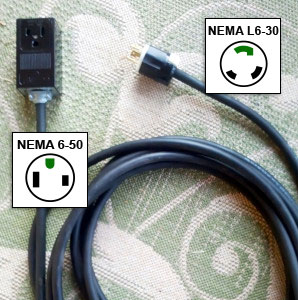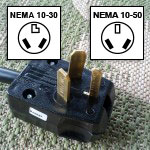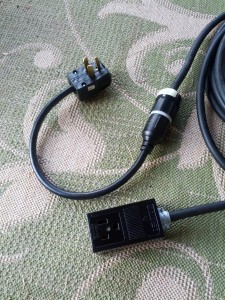Something that could become a challenge on a long trip in an electric car is finding places to charge. The cars can plug in to any regular household outlet, but the current is so low there that it could take all day to charge up. So being able to plug in to higher-powered plugs, such as outlets for clothes dryers or RVs, could potentially be very useful.
Probably the best option for this for a new EV owner would be to get an EVSE Upgrade with whichever adapters you may need. However, I did not know about this when we got our first LEAF, so I purchased a fully fledged wall-mount EVSE instead. However, I did have the foresight to buy one that can plug in to an outlet, rather than requiring to be hard-wired.
 So the EVSE we have in our garage is the AeroVironment EVSE-RS. This is pretty much the same thing you’ll see at most Nissan dealers, but without the Nissan branding. Also, it can be removed from the wall very easily just by pulling a little lever on it. It slides right off. But, the most important thing with this model is that it is designed to plug in to a NEMA 6-50 receptacle on the wall. A NEMA 6-50 outlet is a 208-240V 50A outlet probably usually used for welders and such. I was able to find such a receptacle at Lowe’s and had it installed even before the EVSE itself arrived from Amazon.com.
So the EVSE we have in our garage is the AeroVironment EVSE-RS. This is pretty much the same thing you’ll see at most Nissan dealers, but without the Nissan branding. Also, it can be removed from the wall very easily just by pulling a little lever on it. It slides right off. But, the most important thing with this model is that it is designed to plug in to a NEMA 6-50 receptacle on the wall. A NEMA 6-50 outlet is a 208-240V 50A outlet probably usually used for welders and such. I was able to find such a receptacle at Lowe’s and had it installed even before the EVSE itself arrived from Amazon.com.
On the left here you can see our EVSE installed in the garage. Notice the cord coming out of the left of it plugged in to the outlet. Since it plugs in to an outlet, I was able to create my extension cord and adapters for different kinds of outlets, so we can charge in many places now.
 I decided it would be nice to be able to utilize the adapters that are sold by EVSE Upgrade. Their modification to the EVSE for the 2013 LEAF includes a NEMA L6-30 plug on the end, and they sell adapters from NEMA L6-30 to various other plugs. So I wanted first to adapt from my EVSE’s NEMA 6-50 to NEMA L6-30 to be able to use these adapters.
I decided it would be nice to be able to utilize the adapters that are sold by EVSE Upgrade. Their modification to the EVSE for the 2013 LEAF includes a NEMA L6-30 plug on the end, and they sell adapters from NEMA L6-30 to various other plugs. So I wanted first to adapt from my EVSE’s NEMA 6-50 to NEMA L6-30 to be able to use these adapters.
It’s worth noting that this is an adaptation to a lower amperage socket. This usually isn’t a great idea, and I must tell you that I am NOT an electrician and if I was, I probably wouldn’t do this. However, I know that my EVSE will only draw 30 amps, since I have it connected into an old 30 amp breaker (used to be for a baseboard heater). So I’m taking a little risk.
I also wanted to have a long cord so we could, for example, reach into a relative’s house to plug in to a dryer outlet. I combined these two needs into one 30-foot cable with a NEMA 6-50 receptacle on one end, for the EVSE to plug in to, and a NEMA L6-30 plug on the other end, to use the adapters with. You can see this on the right above.
50-amp RV hook-ups at campgrounds and some electric clothes dryers use various NEMA 14 outlets. EVSE Upgrade sells a single adapter that works in NEMA 14-30, 14-50, and 14-60 (by cutting off the unused neutral pin). I purchased this adapter as-is and the 30-ft cord can plug right in to it. That was easy!

 Other dryers and electric ranges use NEMA 10-30 and 10-50. To support these, I built a cable with the NEMA L6-30 receptacle on one end, and NEMA 10-50 on the other. Then, to make it also fit in NEMA 10-30 outlets, I cut the neutral pin in half, so it’ll fit in one leg of the “L” of a NEMA 10-30, as you can see on the left.
Other dryers and electric ranges use NEMA 10-30 and 10-50. To support these, I built a cable with the NEMA L6-30 receptacle on one end, and NEMA 10-50 on the other. Then, to make it also fit in NEMA 10-30 outlets, I cut the neutral pin in half, so it’ll fit in one leg of the “L” of a NEMA 10-30, as you can see on the left.
Now, with the 30-foot cord on this plus the 25-foot cord on the EVSE itself, we can plug in anywhere we find any of these outlets within 55 feet: 10-30, 10-50, 14-30, 14-50, 14-60, L6-30. We can also plug in within 25 feet of a 6-50 and within 23 feet of a regular 5-15, 5-20, or TT-30 outlet (with yet another little adapter). The total cost, not including the original EVSE, was $174.

Well played! 🙂
Could you share exactly how you wired the L6-30 to the NEMA 10-50. I need to do something very similar, i.e. L6-30 (female) to NEMA 10-30 (male). Just want to be sure I’m wiring it correctly.
For L6-30 to 10-50, I purchased an L6-30 to 10-30 adapter from here. I sliced off part of the L-shaped common pin so that it will also fit into 10-50 (which has a straight common pin).
Thanks for the note. I’m actually going the other way. I happen to have a L6-30 receptacle, due to moving a dryer plug, and purchase of a Clipper Creek with an L6-30 plug. Now I need to connect a device that has a 10-30 male (plug), but need to plug this into a L6-30. It seems that is backwards from all the existing conversion plugs!
I’m pretty sure it’s the obvious ground pin to ground pin. Except one is label W, while the other is labeled G, which I believe has to due with one being a neutral, grounded in the box.
Yeah, one has neutral and the other has ground, but it’ll be treated as ground by your EVSE in either case, and in most houses ground and neutral are connected to the same place anyway. Neutral isn’t really needed since it’s a 220-volt device, anyway.
Ray did you find a solution? I am about to install a L6-50 outlet for my new EVSE and would like to be able to plug my drying (10-30) into it using an adapter.
I am pretty sure you can find a suitable adapter. My problem was needing a female end L6-30. I dain’t need it, so I punted for now.
Oops. Didn’t see you needed an L version plug. You can definitely do it using a junction box with L6-50 receptacle in it, rather than finding a plug end L6-50 receptacle. Wire it in parallel with the other junction box. Don’t use both at same time. :).
.